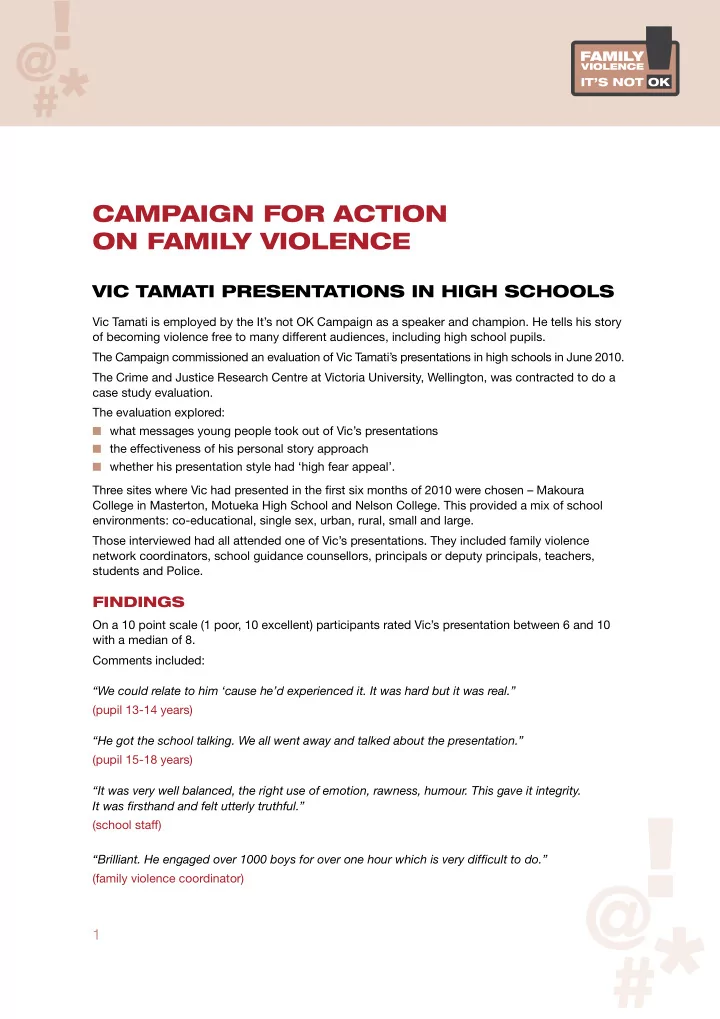

CAMPAIGN FOR ACTION ON FAMIL Y VIOLENCE VIC TAMATI PRESENTATIONS IN HIGH SCHOOLS Vic Tamati is employed by the It’s not OK Campaign as a speaker and champion. He tells his story of becoming violence free to many different audiences, including high school pupils. The Campaign commissioned an evaluation of Vic Tamati’s presentations in high schools in June 2010. The Crime and Justice Research Centre at Victoria University, Wellington, was contracted to do a case study evaluation. The evaluation explored: ■ what messages young people took out of Vic’s presentations ■ the effectiveness of his personal story approach ■ whether his presentation style had ‘high fear appeal’. Three sites where Vic had presented in the fjrst six months of 2010 were chosen – Makoura College in Masterton, Motueka High School and Nelson College. This provided a mix of school environments: co-educational, single sex, urban, rural, small and large. Those interviewed had all attended one of Vic’s presentations. They included family violence network coordinators, school guidance counsellors, principals or deputy principals, teachers, students and Police. FINDINGS On a 10 point scale (1 poor, 10 excellent) participants rated Vic’s presentation between 6 and 10 with a median of 8. Comments included: “We could relate to him ‘cause he’d experienced it. It was hard but it was real.” (pupil 13-14 years) “He got the school talking. We all went away and talked about the presentation.” (pupil 15-18 years) “It was very well balanced, the right use of emotion, rawness, humour. This gave it integrity. It was fjrsthand and felt utterly truthful.” (school staff) “Brilliant. He engaged over 1000 boys for over one hour which is very diffjcult to do.” (family violence coordinator) 1
All students interviewed had excellent recall of Vic’s presentation and the It’s not OK Campaign’s three core messages: ■ violence is not OK ■ change is possible ■ it is OK to ask for help. Students consistently referred to the authenticity of Vic’s story. “We understood and took it seriously and respected what Vic had to say because it was real.” (pupil 16-17) Students at each of the three schools said they had discussed Vic’s presentation with their parents. CHANGES IN BEHAVIOUR AND ATTITUDES Police reported a signifjcant behaviour change in a parent who had attended Vic’s presentation. One school sought family violence information from the local network in response to a student’s disclosure, which led to development of a staff training package. Staff noted that more students had come forward asking for help about bullying and senior students seemed more willing to step in to address scuffmes or bullying. The presentation led some students to refmect on their own behaviour: “It made me think because I do call people names and I think about that sometimes I do bully people.” (pupil 13-14) In one community Vic’s presentation led to an invitation for him to speak to the local Pacifjc community. This was regarded as a signifjcant shift as a number of taboos had prevented discussion of family violence in Pacifjc church communities. 2
FEAR APPEALS Participants were asked if they felt fear as a result of attending Vic’s presentation. Presentations which arouse fear can cause listeners to disengage and fail to absorb the intended messages. None of those interviewed across all groups felt that Vic used fear arousing techniques. “This was not about fear, it was providing kids with a story that they can relate to, something to think about and to realise that violence is not OK and that you can change.” (staff member) SCHOOL PREPARATION It is important for each school to prepare for Vic’s presentation and to have support people on hand for students who disclose violence at home. Recommended preparations include: ■ explaining the reason for the presentation and giving it context ■ a warning that content is explicit ■ ensuring students know what support is available if they are upset or disclose. Vic’s presentations are most effective when they are part of a programme in the school to address violence. CONCLUSION The study found a high degree of similarity across participants and case study sites and a high degree of satisfaction with Vic Tamati’s presentations. Also of note was the extent to which students were able to recall and understand the three Campaign messages. Participants agreed that Vic used an optimal degree of imagery to engage his audience. Students believed this high level of engagement enabled them to recall the Campaign messages and engage in attitude and behaviour changes. 3
Recommend
More recommend